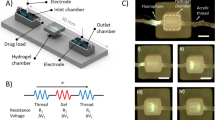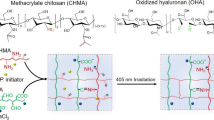Abstract
Many surgeries are complicated by the need to anastomose, or reconnect, micrometre-scale vessels. Although suturing remains the gold standard for anastomosing vessels, it is difficult to place sutures correctly through collapsed lumen, making the procedure prone to failure. Here, we report a multiphase transitioning peptide hydrogel that can be injected into the lumen of vessels to facilitate suturing. The peptide, which contains a photocaged glutamic acid, forms a solid-like gel in a syringe and can be shear-thin delivered to the lumen of collapsed vessels (where it distends the vessel) and the space between two vessels (where it is used to approximate the vessel ends). Suturing is performed directly through the gel. Light is used to initiate the final gel–sol phase transition that disrupts the hydrogel network, allowing the gel to be removed and blood flow to resume. This gel adds a new tool to the armamentarium for micro- and supermicrosurgical procedures.
This is a preview of subscription content, access via your institution
Access options
Subscribe to this journal
Receive 12 print issues and online access
$259.00 per year
only $21.58 per issue
Buy this article
- Purchase on Springer Link
- Instant access to full article PDF
Prices may be subject to local taxes which are calculated during checkout






Similar content being viewed by others
References
Gardiner, M. D. & Nanchahal, J. Strategies to ensure success of microvascular free tissue transfer. J. Plastic Reconst. Aesth. Surg. 63, E665–E673 (2010).
MacDonald, J. D. Learning to perform microvascular anastomosis. Skull Base 15, 229–240 (2005).
Pratt, G. F. et al. Technology-assisted and sutureless microvascular anastomoses: evidence for current techniques. Microsurgery 32, 68–76 (2012).
Alghoul, M. S. et al. From simple interrupted to complex spiral: a systematic review of various suture techniques for microvascular anastamoses. Microsurgery 31, 72–80 (2011).
Bui, D. T. et al. Free flap reexploration: indications, treatment, and outcomes in 1193 free flaps. Plast. Reconstr. Surg. 119, 2092–2100 (2007).
Disa, J. J., Cordeiro, P. G. & Hidalgo, D. A. Efficacy of conventional monitoring techniques in free tissue transfer: an 11-year experience in 750 consecutive cases. Plast. Reconstr. Surg. 104, 97–101 (1999).
Nakayama, Y. & Matsuda, T. Photocurable surgical tissue adhesive glues composed of photoreactive gelatin and poly(ethylene glycol) diacrylate. J. Biomed. Mater. Res. 48, 511–521 (1999).
Rickett, T. A. et al. Rapidly photo-cross-linkable chitosan hydrogel for peripheral neurosurgeries. Biomacromolecules 12, 57–65 (2011).
Schneider, J. P. et al. Responsive hydrogels from the intramolecular folding and self-assembly of a designed peptide. J. Am. Chem. Soc. 124, 15030–15037 (2002).
Nagy, K. J., Giano, M. C., Jin, A., Pochan, D. J. & Schneider, J. P. Enhanced mechanical rigidity of hydrogels formed from enantiomeric peptide assemblies. J. Am. Chem. Soc. 133, 14975–14977 (2011).
Haines-Butterick, L. et al. Controlling hydrogelation kinetics by peptide design for three-dimensional encapsulation and injectable delivery of cells. Proc. Natl Acad. Sci. USA 104, 7791–7796 (2007).
Pochan, D. J. et al. Thermally reversible hydrogels via intramolecular folding and consequent self-assembly of a de novo designed peptide. J. Am. Chem. Soc. 125, 11802–11803 (2003).
Rajagopal, K., Ozbas, B., Pochan, D. J. & Schneider, J. P. Probing the importance of lateral hydrophobic association in self-assembling peptide hydrogelators. Eur. Biophys. J. 35, 162–169 (2006).
Branco, M. C., Pochan, D. J., Wagner, N. J. & Schneider, J. P. The effect of protein structure on their controlled release from an injectable peptide hydrogel. Biomaterials 31, 9527–9534 (2010).
Salick, D. A., Pochan, D. J. & Schneider, J. P. Design of an injectable beta-hairpin peptide hydrogel that kills methicillin-resistant Staphylococcus aureus. Adv. Mater. 21, 4120–4123 (2009).
Sinthuvanich, C., Haines-Butterick, L. A., Nagy, K. J. & Schneider, J. P. Iterative design of peptide-based hydrogels and the effect of network electrostatics on primary chondrocyte behavior. Biomaterials 33, 7478–7488 (2012).
Rughani, R. V., Branco, M. C., Pochan, D. J. & Schneider, J. P. De novo design of a shear-thin recoverable peptide-based hydrogel capable of intrafibrillar photopolymerization. Macromolecules 43, 7924–7930 (2010).
Yan, C. Q. et al. Injectable solid hydrogel: mechanism of shear-thinning and immediate recovery of injectable beta-hairpin peptide hydrogels. Soft Matter 6, 5143–5156 (2010).
Canepari, M., Nelson, L., Papageorgiou, G., Corrie, J. E. T. & Ogden, D. Photochemical and pharmacological evaluation of 7-nitroindolinyl-and 4-methoxy-7-nitroindolinyl-amino acids as novel, fast caged neurotransmitters. J. Neurosci. Methods 112, 29–42 (2001).
Matsuzaki, M. et al. Dendritic spine geometry is critical for AMPA receptor expression in hippocampal CA1 pyramidal neurons. Nature Neurosci. 4, 1086–1092 (2001).
Hutchinson, E. G., Sessions, R. B., Thornton, J. M. & Woolfson, D. N. Determinants of strand register in antiparallel beta-sheets of proteins. Protein Sci. 7, 2287–2300 (1998).
Wouters, M. A. & Curmi, P. M. G. An analysis of side chain interactions and pair correlations within antiparallel beta-sheets—the differences between backbone hydrogen-bonded and non-hydrogen-bonded residue pairs. Prot. Struct. Funct. Genet. 22, 119–131 (1995).
Huang, Y. et al. Microvascular anastomosis guidance and evaluation using real-time three-dimensional Fourier-domain Doppler optical coherence tomography. J. Biomed. Opt. 18, 111404 (2013).
Huang, Y. et al. Evaluation of microvascular anastomosis using real-time, ultra-high-resolution, Fourier domain Doppler optical coherence tomography. Plast. Reconstr. Surg. 135, 711E–720E (2015).
Zuman, P. & Shah, B. Addition, reduction, and oxidation reactions of nitrosobenzene. Chem. Rev. 94, 1621–1641 (1994).
Papageorgiou, G., Ogden, D. & Corrie, J. E. T. An antenna-sensitized nitroindoline precursor to enable photorelease of L-glutamate in high concentrations. J. Org. Chem. 69, 7228–7233 (2004).
Acknowledgements
This research was supported by the Intramural Research Program of the National Institutes of Health, the National Cancer Institute, and the Center for Cancer Research. The authors thank B. Bush for performing the atomic force microscopy analysis.
Author information
Authors and Affiliations
Contributions
D.J.S., G.A.B., G.B. and J.P.S. conceived the research. D.J.S., S.H.M. and K.J.N.-S. were responsible for the synthesis, biophysical and rheological characterization of the materials. G.A.B., D.T., Y.H., J.G., G.J.F., B.C.O., P.W. and S.H.M. performed animal experiments. D.J.S., S.H.M., G.B. and J.P.S. wrote the manuscript.
Corresponding author
Ethics declarations
Competing interests
The authors declare no competing financial interests.
Supplementary information
Supplementary information
Supplementary information (PDF 5276 kb)
Supplementary Movie 1
Supplementary Movie 1 (MOV 12529 kb)
Supplementary Movie 2
Supplementary Movie 2 (MOV 94039 kb)
Rights and permissions
About this article
Cite this article
Smith, D., Brat, G., Medina, S. et al. A multiphase transitioning peptide hydrogel for suturing ultrasmall vessels. Nature Nanotech 11, 95–102 (2016). https://doi.org/10.1038/nnano.2015.238
Received:
Accepted:
Published:
Issue Date:
DOI: https://doi.org/10.1038/nnano.2015.238
This article is cited by
-
Cell spheroid creation by transcytotic intercellular gelation
Nature Nanotechnology (2023)
-
Accelerating the prediction and discovery of peptide hydrogels with human-in-the-loop
Nature Communications (2023)
-
Current hydrogel advances in physicochemical and biological response-driven biomedical application diversity
Signal Transduction and Targeted Therapy (2021)
-
Reversible electroadhesion of hydrogels to animal tissues for suture-less repair of cuts or tears
Nature Communications (2021)
-
Biomimetic peptide self-assembly for functional materials
Nature Reviews Chemistry (2020)



